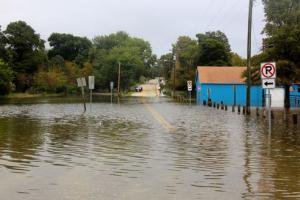Coastal resilienceNew Web portal for coastal resilience
William & Mary Law School and William & Mary’s Virginia Institute of Marine Science (VIMS) are collaborating on a new Web site which will provide key information to support local, regional, and state efforts to adapt to sea-level rise. Tidal and storm surge flooding risks, FEMA flood zone maps, storm history, and critical infrastructure risk assessments are all topics that are likely to be included on the Web site. Information about conditions of shorelines, wetlands, beaches, and coastal forests will also be in the portal.

William and Mary spearheads development of coastal resilience portal // Source: wm.edu
William & Mary Law School and William & Mary’s Virginia Institute of Marine Science (VIMS) are collaborating on a new Web site which will provide key information to support local, regional, and state efforts to adapt to sea-level rise, thanks to a $1.2 million grant from blue moon fund. William and Mary says that the grant will provide funding for the Virginia Coastal Adaptation Data Portal, a Web site which will give a variety of information, data, analyses, and tools useful for risk assessment and adaptation planning. Hampton Roads has the highest rate of sea-level rise on the East Coast, putting the region at a heightened risk of recurrent flooding and stormwater damage.
“VIMS is gratified to be a lead in this type of collaboration,” said John T. Wells, dean and director of VIMS, which is home to W&M’s School of Marine Science. “Virginia is on the front lines of sea-level rise and recurrent flooding, and these types of collaborations are critical to the future of coastal communities as we come together to innovate and find new ways to adapt to our changing environment.”
Development of the data portal will be a collective effort among VIMS, William & Mary Law School’s Virginia Coastal Policy Center (VCPC) and Wetlands Watch, a non-profit in Norfolk, Va. focused on the conservation and protection of wetlands.
Portal development and operation will also be closely tied to the research, training, data integration, and outreach activities of the new state-funded Commonwealth Center for Recurrent Flooding Resiliency. The Center, funded through legislation enacted during the 2016 session by the General Assembly and announced today in an Earth Day event by Governor Terry McAuliffe, is a collaborative partnership among VIMS, VCPC, and Old Dominion University.
Wells says the center “is a perfect example of VIMS’ ability to leverage academic partnerships and private grant funding for the public good.”
When completed, the Web portal will provide officials at all levels of the government, as well as the public, with vital information with the click of a button. “For many policy makers and private citizens, sea-level rise is overwhelming because it’s rapidly evolving,” said Carl Hershner, director of VIMS’ Center for Coastal Resources Management. “This will be a trusted source of information where people can go to try to make sense of all this, and get information they can act on. VIMS was created to provide this kind of service
